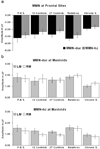Are auditory-evoked frequency and duration mismatch negativity deficits endophenotypic for schizophrenia? High-density electrical mapping in clinically unaffected first-degree relatives and first-episode and chronic schizophrenia
- PMID: 18472090
- PMCID: PMC3057136
- DOI: 10.1016/j.biopsych.2008.03.019
Are auditory-evoked frequency and duration mismatch negativity deficits endophenotypic for schizophrenia? High-density electrical mapping in clinically unaffected first-degree relatives and first-episode and chronic schizophrenia
Abstract
Background: Mismatch negativity (MMN) is a negative-going event-related potential (ERP) component that occurs in response to intermittent changes in constant auditory backgrounds. A consistent finding across a large number of studies has been impaired MMN generation in schizophrenia, which has been interpreted as evidence for fundamental deficits in automatic auditory sensory processing. The aim of this study was to investigate the extent to which dysfunction in MMN generation might represent an endophenotypic marker for schizophrenia.
Methods: We measured MMN to deviants in duration (25 msec, 1000 Hz) and deviants in pitch (50 msec, 1200 Hz) relative to standard tones (50 msec, 1000 Hz) in 45 chronic schizophrenia patients, 25 of their first-degree unaffected biological relatives, 12 first-episode patients, and 27 healthy control subjects.
Results: In line with previous work, MMN amplitudes to duration deviants (but not to pitch deviants) were significantly reduced in patients with chronic schizophrenia compared with control subjects. However, both duration and pitch MMNs were completely unaffected in the first-degree biological relatives and this was also the case for the first-episode patients. Furthermore, length of illness did not predict the extent of MMN deficit.
Conclusions: These findings suggest that the MMN deficit seen in schizophrenia patients is most likely a consequence of the disease and that MMN, at least to basic auditory feature deviants, is at best only weakly endophenotypic for schizophrenia.
Conflict of interest statement
The authors declare that no conflict of interest, financial or otherwise, is related directly or indirectly to the submitted work.
Figures




References
-
- Weinberger DR, Gallhofer B. Cognitive function in schizophrenia. Int Clin Psychopharmacol. 1997;12 Suppl 4:S29–S36. - PubMed
-
- Goldberg TE, Gold JM. In: Bloom FE, Kupfer DJ, editors. New York: Raven Press; 1995. pp. 1245–1257.
-
- Goldman-Rakic PS. Working memory dysfunction in schizophrenia. J Neuropsychiatry Clin Neurosci. 1994;6:348–357. - PubMed
-
- Green MF, Nuechterlein KH, Gaier DJ. Sustained and selective attention in schizophrenia. Prog Exp Pers Psychopathol Res. 1992;15:290–313. - PubMed
-
- Foxe JJ, Doniger GM, Javitt DC. Early visual processing deficits in schizophrenia: impaired P1 generation revealed by high-density electrical mapping. Neuroreport. 2001;12:3815–3820. - PubMed
Publication types
MeSH terms
Grants and funding
LinkOut - more resources
Full Text Sources
Medical

